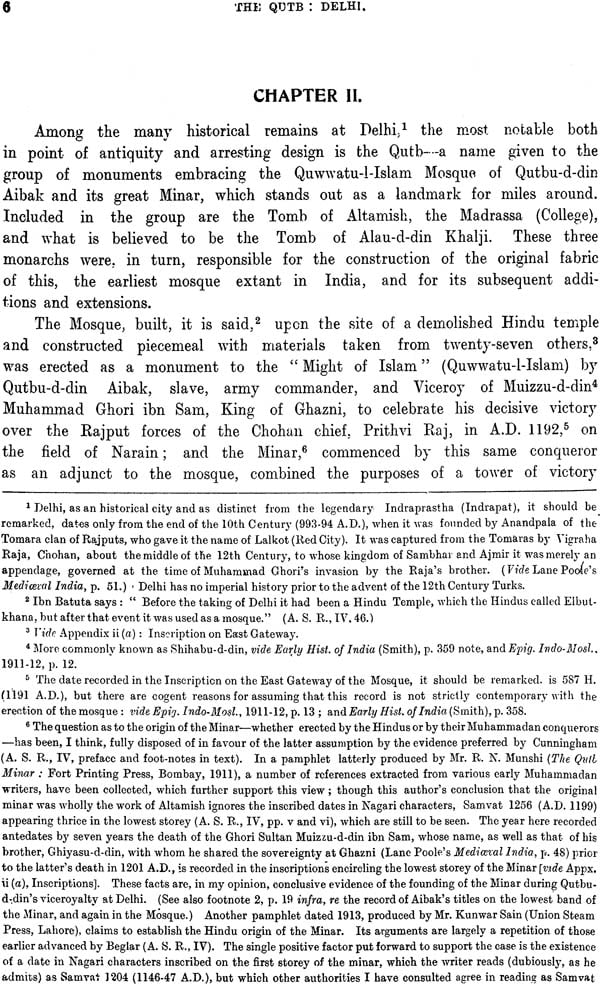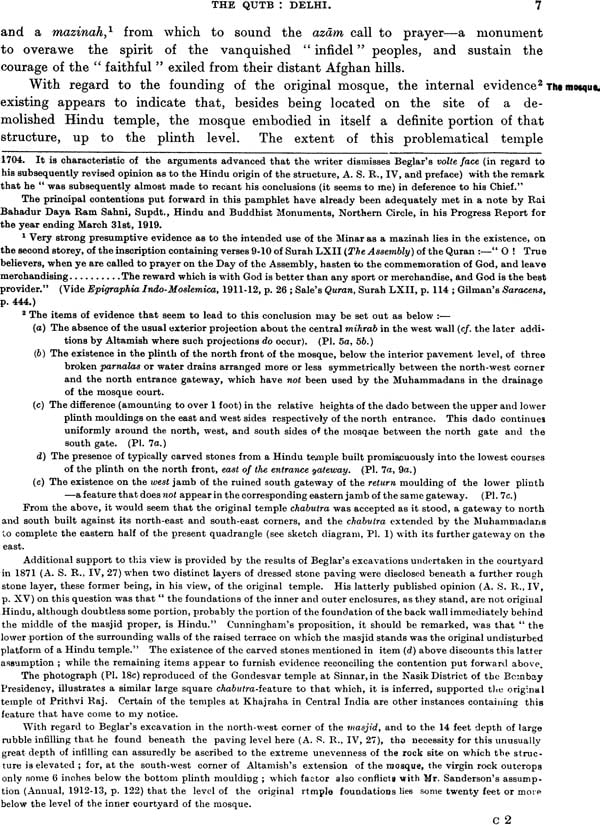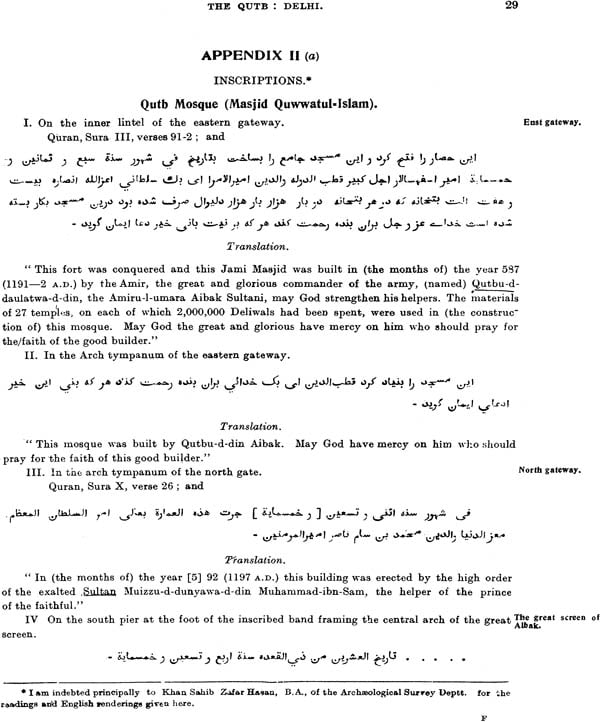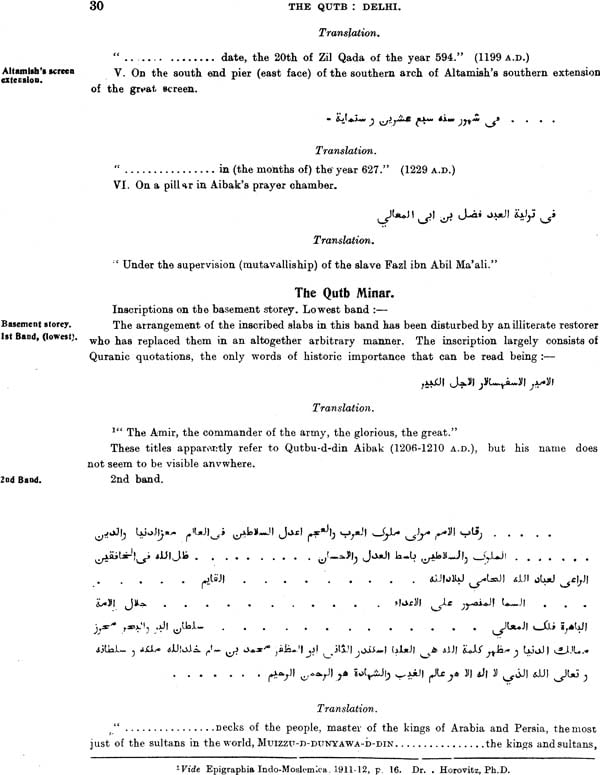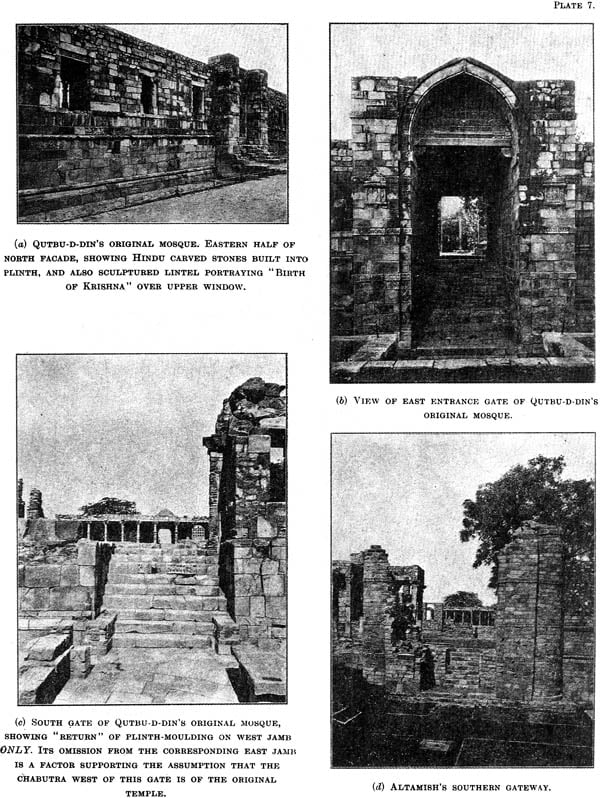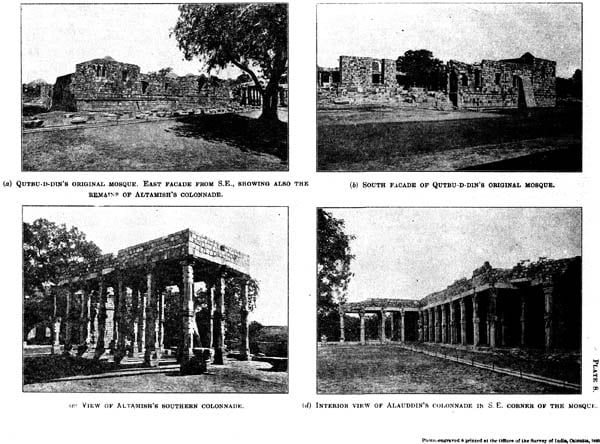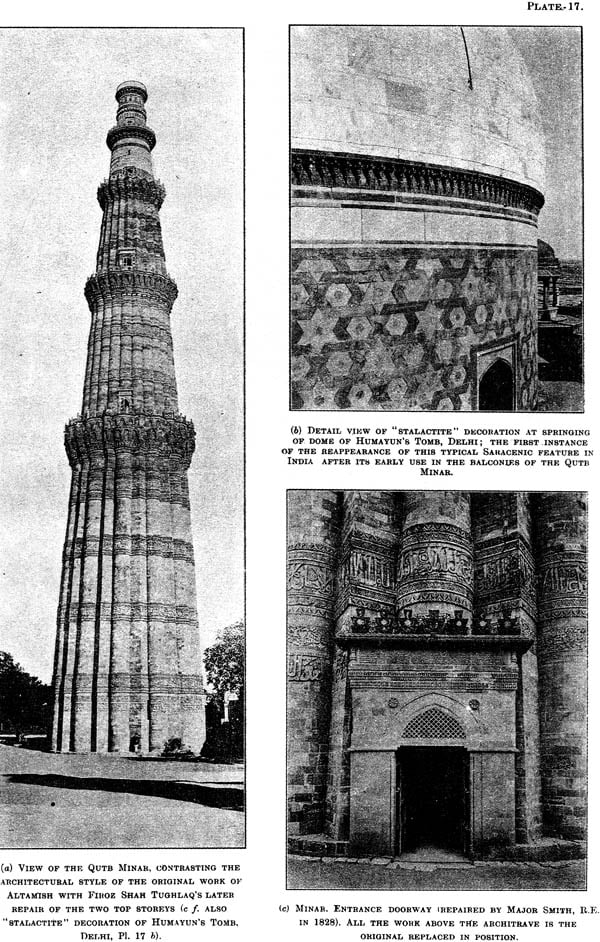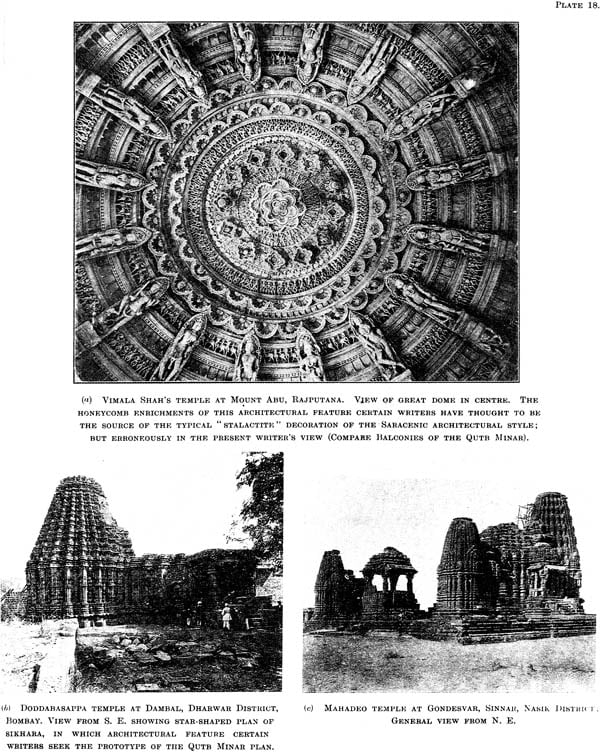
An Historical Memoir on The Qutb: Delhi
Book Specification
| Item Code: | NAL921 |
| Author: | J. A. Page |
| Publisher: | Archaeological Survey of India |
| Language: | English |
| Edition: | 1998 |
| Pages: | 128 (62 Plates B/W Illustrations) |
| Cover: | Hardcover |
| Other Details | 10.5 inch X 8.5 inch |
| Weight | 750 gm |
Book Description
In approaching the subject in this preliminary chapter my aim will be limited to sketching lightly a general outline of the evolution of the Indo-Saracenic architectural style, bringing into relief the salient features that characterise its more prominent phases; and, in conjunction with this, to giving a very brief resume of the more important events of contemporary political history attending this development. To deal fully with such a subject would require several volumes, and is far beyond the scope of a preface to a memoir on one particular example, albeit an extremely important one, of Muhammadan architecture in India.
It is primarily to the Ghorid occupation of the 12th Century that we owe the Muhammadan architecture of India. Whatever traditions and influence the Semitic Arab may have brought with him on his invasion of Sindh in the beginning of the 8th Century A.D., they have left no trace on the subsequent architectural history of India; and are now only recorded in a few Arabian place-names such as Mansura, and In titular designations such as Mir.
The descendants of the Ghaznavi invaders, again" who found in the Panjab a precarious refuge on the final break-up of Mahmud Ghaznavi's empire in the 12th Century, became Indianised and absorbed in the native population, even as did those of the Arab settlers along the Indus a few centuries before; and, like the latter, they left no permanent mark on the civilisation and arts of the country they occupied-none, at any rate, that is traceable in the archaeological remains that are left to us to-day.
In the case of the later Ghaznavides this is all the more to be regretted since their buildings in Lahore might well have brought us a stage nearer to the architectural style of the Ghazni of “Mahmud the Great,” obliterated for ever in the destruction of that city in 1155 A.D. For it is in the architecture of Ghazni that we must seek the seed that was brought to India by Muhammad Ghori, and germinated under the Turki Slave dynasty that succeeded to the Delhi Kingdom in the 13th Century A.D.
With the conquest of Sindh by the Arab, Muhammad ibn Qasim, in 712 A.D., and the later occupation of the northern Panjab that followed upon Mahmud of Ghazni's raids between the years 100.0-26, . we are thus not immediately concerned. The architectural history proper of Muhammadan India commences with Muhammad Ghori's occupation in 1192 A.D., a date that marks the beginning of some seven centuries of uninterrupted Muslim rule in India.
It was characteristic of the Arabs 'in the earliest campaigns of invading Islam that their architectural styles in embryo borrowed largely from the indigenous elements of the countries' they had overrun. By the time that India was brought under the permanent subjection of the Muslim, however, the Saracenic architectural style had already. crystallised into defined forms, and we see at the Qutb how quickly the borrowed elements of the Indian temple architecture were discarded, and how comparatively little was absorbed into the maturing Indo-Saracenic style. A few bracket types of Hindu corbel pursue their way right through to the Earlier Mughal period of the 16th Century, and here and there, perhaps, a column 01' pier is reminiscent of the plainer Hindu designs; but for the rest the character of the Muhammadan architectural style in India is noticeably distinct.
Indigenous ornament of flowing semi-naturalistic pattern is accepted faute de mieux for the decoration of the earliest portions of the Qutb, as, for instance, in the embellishment of the great arcaded screen. But this is quickly discarded in favour of the more orthodox patterns as soon as the immigration of skilled Saracenic craftsmen permits of their adoption.
The temple architecture of the Chohan Kingdom embracing Delhi, Sambhar and Ajmir (circa 800-1192 A.D.) which succumbed to the Ghorid invaders had thus little abiding influence upon the architecture of the succeeding Turkish dynasty: the adaptation of Hindu constructional members, such as columns, domes, etc., to meet the immediate needs of the mosque builders was purely a temporary make-shift, to be discarded I1S soon as craft facilities should permit.
From the introduction of the Indo-Saracenic style at the Qutb its architecture goes forward through several distinct, though merging, phases. The Slave dynasty (1206-90), terminating virtually with Balban, coincides with the transitional stage of the new intruding style, as it is manifested in the Qutb mosque and the Tomb of Altamish at Delhi, and again in the Adhai-din-ka- jhompra mosque at Ajmir, where Hindu elements still persist, though in an increasingly subordinate degree.
With the architecture of the succeeding Afghan dynasty of the Khaljis (1290-1321 A.D.), as revealed in the Gateway of Alau-d-din at the Qutb, and ‘the Jama'at Khana at Nizamu-d-din, Delhi, a marked change in style appears, more consistently Saracenic in its general design and in the technique of its decoration. The contrast with the preceding phase is heightened by the use of new materials, and now begins a vogue of red sandstone, and decorative marble reliefs, which holds sway through the earlier reigns of the following Tughlaqi dynasty (as displayed in the tomb of Ghiyasu-d-din at Tughlaqabad, and in the contemporary Rikabwali Gumbaz near Old Delhi), and is prominent again in the architecture of the Mughals.
The sturdy vigour and impressive design of the earlier Tughlaqi architecture throw it into conspicuous relief with the staid, work-a-day structuresof Firozshah Tughlaq's reign; though these again are markedly individualistic in design, with their multi-domed roofing, their plain battered walls, and attenuated minar-buttressing at the quoins.
It is at this period that the flame of genius burns most brightly in the architecture of the several Provincial dynasties into which the kingdom of Firozshah split up after his death and the ensuing irruption of the Tartar invader Timur in 1398 A.D. The architecture of Gujarat,. Jaunpur, Malwa, Bengal and the Dekhan stands almost unrivalled in its refined beauty and vigour of design; each phase distinct with its own individual character, a local modification of the common parent style of Delhi in which it had its origin.
The salvage of some residue of central authority by the two succeeding dynasties of the Indian Sayyids and Afghan Lodis, which ruled over the greatly circumscribed Delhi kingdom between the years 1414 and 1526 A.D., is commemorated in the existence of the group of tombs at Khairpur, and the Moth- ki- Masjid, near Delhi. Here one finds features developed from the Firozshah period-mihrab-panelled architraves enclosing an arched entrance doorway, as well as an original treatment of coloured tile decoration sparingly inset m friezes and, as in the mosque at Khairpur, of intricately incised surfaces of plaster arabesque. Octagonally planned tomb chambers enclosed within a surrounding aisle, each external angle of the polygonal facades emphasised by sloping buttresses, bestow both originality and distinction upon this all but final phase of Pathan architecture in India.
The overthrow of the disintegrating Pathan kingdom by the Mughal adventurer Babar in 1526 A.D. put a period to the architecture of the Lodis, and in his hurriedly constructed mosque at Panipat in the southern Panjab one discerns already an incipient change in style, ill-defined as yet and. marked most in the indecisive dome contour, but none the less heralding the eventual glories of the Mughal Capitals of the 16th and 17th Centuries A.D.
The usurpation of the Mughal throne by the Suri dynasty of Afghans between the years 1539 and 1555 A.D. is responsible for the vigorous and quite distinct architectural style exemplified in the Purana Qila at Delhi and its Qila-i-Kuhna Mosque-a style characterised by the use of grey quartzite with red sandstone dressings lavishly inset with black and white marble bands, by a developed pendentive construction of dome support, and by the adoption at the rear quoins of a mosque of engaged angular turrets divided by balconies into fenestrated storeys; a feature that also distinguishes the earlier Moth-Ki-Mosjid and the Jamali Mosque at Mehrauli, and that reappears in a modified form in the later Mughal style.
With the return of the 31nghal'S the contemporary architecture of Persia makes its influence increasingly felt, and culminates in the intricately wrought and brightly coloured inlaid tile decoration and the high- drummed domes that especial feature of the 17th Century architecture of Lahore, and in the Marble purity of the contemporary monuments at Delhi and Agra. A delicate treatment of inlaid marble set with semi- precious stones exquisitely blended in colour and marking to represent the petals and curving tendrils of conventional flowers is a conspicuous feature of the architecture of this period-to be seen in the marble palaces of the three Mughal Capitals and par excellence in the Mausoleum of t he Taj. A concurrent phase is characterised by the comprehensive use of red Agra sandstone sparingly relieved with a delicate white marble inlay applied to a kangura-frieze or to the slender attached shafts of lotus-capped minarets; a façade lightly panelled in mihrab-shaped squares, sometimes inset with a multiplicity of tiny crenellated niches-features common to the subsidiary buildings of the Sikandarah of Jahangir and of the Taj of Shahjahan.
In the preceding architecture of Akbar (1556-1605 A.D.) a predominating Hindu influence (doubtless reflective of that emperor's unorthodox catholicity of outlook) is apparent in the general trabeate form of construction that frequently characterizes it, of which He Fathpur-Sikri palaces and the Akbari buildings in the Agra Fort may be cited as examples.
With the period of Shahjahan the Mughal architectural style attains its zenith, and the reign of the succeeding emperor Aurangzib coincides with a tendency, as yet incipient but becoming increasingly marked, to emasculate decadence-over-elaboration of ornamental detail with a lack of restraint in its application-which descends through all the Rococo redundance of the Nawabi architecture of Oudh to complete the cycle in the non-descript bastard style of to-day; a progress helped on its downward way by the influence of the quasi-European architecture of the 19th Century, of which, again, one sees examples enough in Lucknow.
This very brief introduction, while merely touching the fringe of the subject, may serve to illustrate the position occupied by the Qutb monuments in the sequence of development of the Saracenic architecture of India. The salient political events affecting this development have also been briefly reviewed ; and for a tabulated list of the kings and dynasties of Muhammadan India, as well as the Hindu dynasty of Chohan Rajputs at Delhi which succumbed to them, a reference is invited to Appendix i at the end of this volume.
| List of Works consulted | iii | |
| List of Plates (drawings) | v | |
| List of Plates (photographs) | vii | |
| The Qutb; Delhi. Chapter I, Introductory | 1 | |
| The Qutb; Delhi. Chapter II | 6 | |
| Appendix i. | Kings of the Hindu Chohan dynasty and of the Muhammadan dynasties of Delhi | 27 |
| Appendix ii. (a) | Arabic Inscriptions | 29 |
| (b) | Nagari Inscriptions | 39 |
| Appendix iii. (a) | Note on the Gupta inscription on the Iron Pillar | 44 |
| (b) | Note on the modern inscriptions on the Iron Pillar, Rai Bahadur Daya Ram Sahni, M.A. | 45 |
| Appendix iv. (a) | Resume of Excavation and Conservation Work carried out at the Qutb | 46 |
| (b) | Annual expenditure on same: totals | 49 |
